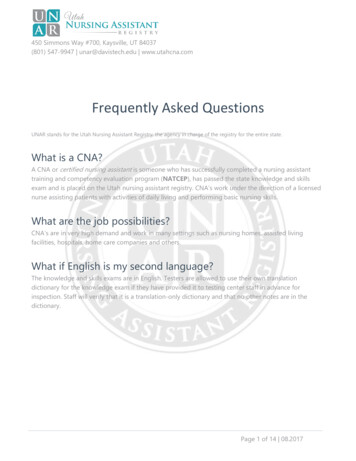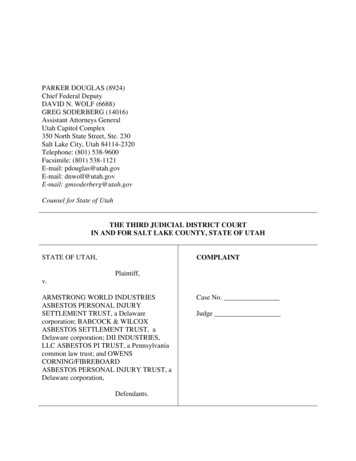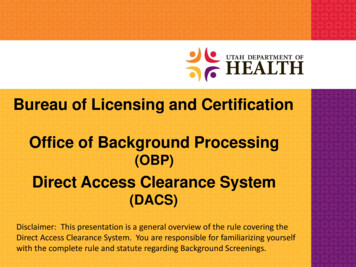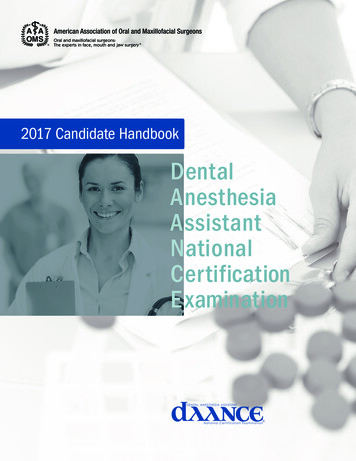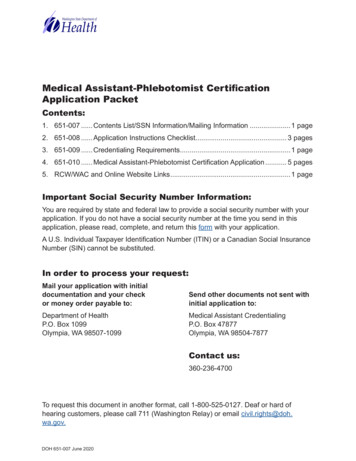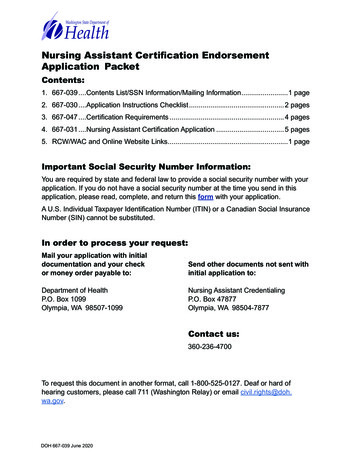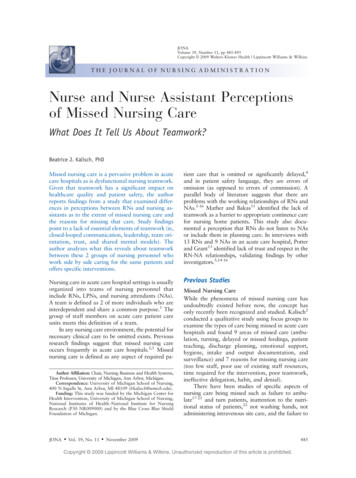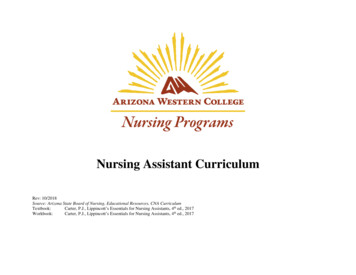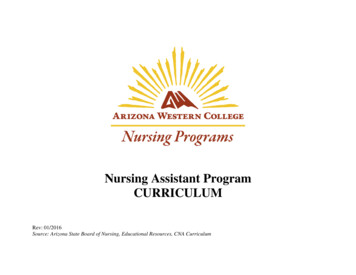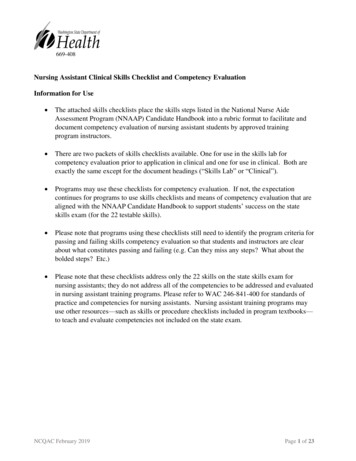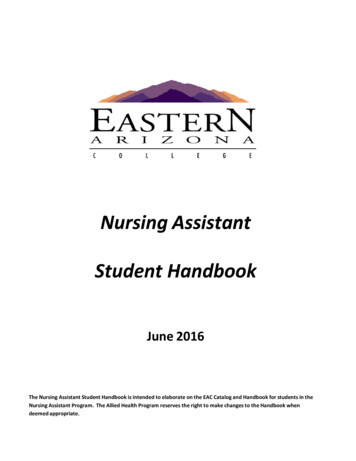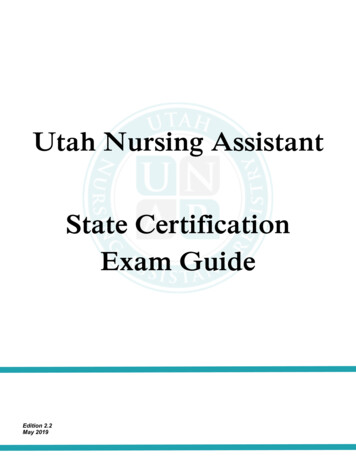
Transcription
Utah Nursing AssistantState CertificationExam GuideEdition 2.2May 2019
UNAR State Certification Exam GuideIntroductionThe nursing assistant certification process in theState of Utah requires that you demonstrateminimum competency by passing both aknowledge and skills demonstration exam uponcompletion of your nursing assistant training.You have 1 year from the date of completion fromyour training program to pass both portions of theexam. Students who test soon after completinghave a significantly higher pass rate than thosewho wait more than 3 months.SkillsThe State of Utah requires that each studentcompleting a nursing assistant course learn anddemonstrate the ability to perform more than 70skills. This is documented while enrolled in atraining program by completing the UNARNursing Assistant Skill Proficiency PerformanceList (NAPP). Of the 70 skills learned, 22 havebeen identified for inclusion in the state skillsexam and are included in this guide. Of these 22,you will be expected to perform 5 random skillsduring the state test. To pass the skill exam youmust receive a minimum score of 80% for eachskill performed along with 100% of key steps andcomplete testing within 45 minutes.KnowledgeThe knowledge portion of the exam consists of 75multiple-choice questions. In order to pass theknowledge test you must receive a minimumscore of 75%. This means you must answer aminimum of 57 questions correctly to pass thisportion of the exam. The exam questions areselected randomly by the testing software from alarge pool of questions that have been approvedby a UNAR Test Advisory Panel. The panelconsists of nursing assistant instructors from theState of Utah. Each question has been reviewedfor accuracy and appropriateness by the panel.You have up to 2 hours to complete the exam.Testmaster Universe (TMU)TMU is the software program that is used byUNAR to provide certification testing andmaintain registry records. Upon completion of atraining program or by means of reciprocity, eachindividual is assigned their own personal portaland username and password. You will need yourusername and password when you take yourknowledge test.You will have access to this portal throughoutyour CNA career, using it to keep your contactinformation up to date and accessing certificationrenewal documents.Where to TestUNAR has independent testing site partnersacross the state in Blanding, Cedar City,Kaysville, Hurricane, Lehi, Logan, Moab,Ogden, Price, Richfield, Roosevelt, Salt LakeCity, St. George, Tooele, and Vernal.Test SchedulingEach test site is run independently and sets theirown schedule. To view the most current list of ourtesting sites, visit UNAR’s website atutahcna.com and view the Test Site Informationdocument. This document will also list each site’stesting hours and whether an appointment isrequired for the knowledge exam or if theywelcome walk-ins. Appointments are alwaysrequired for the skill exam. This document canalso be viewed in your TMU personal portal.To schedule a test with a specific test site, youmust login to your TMU personal portal and payfor the test. Testing fees are non-refundable.1 Page
Once you have paid for your test, you will be ableto access all the testing appointments that areavailable. You can also reschedule any testingappointments through your TMU personal portal.Step-by-step scheduling instructions can befound on utahcna.com.Any changes or cancellations to a testingappointment must be made at least 1 fullbusiness day prior to your testingappointment. If you fail to show up to yourscheduled appointment, you will forfeityour testing fee.What are you allowed to have with youduring testing?Personal items are to be stored according to testsite policy. No cell phones are allowed. You mayuse a calculator, scratch paper, and pencil/pen, allof which are provided by the testing site. Atranslation dictionary is allowed but must beprovided to the testing center in advance forinspection and may not contain definitions oradded notes.All equipment needed for the skills test will beprovided by the testing site including bloodpressure cuff, stethoscope, and a watch.Dress for Skills ExamIf you schedule an appointment for yourknowledge test and later decide you would like totest as a walk-in, you must first cancel yourtesting appointment. If you miss your scheduledappointment, you will forfeit your testing fee.ID RequirementsA current, valid, photo ID must be presented attime of testing and must be the original ID.(Photo, fax, or digital copies will not beaccepted.) First and last name on ID must matchfirst and last name of tester in TMU. ID must havean expiration date and must be current. Thefollowing forms of ID are acceptable: Driver's license, learner's permit, ortemporary operator card from any stateID issued by any branch, department, oragency of the US or State of UtahHigh school, technical school, college, orprofessional school within the State ofUtah (may not have expiration date butmust be current school year)A tribal ID cardPassport from any countryAll examinees must wear scrubs, closed toeshoes, have their hair tied back, and no danglingjewelry.Physical LimitationsYou will not be allowed to take the skills exam ifyou have an injury, serious illness or are morethan 6 months pregnant without providing thetesting site with a health care providers release towork full duty as a CNA.AccommodationsAccommodations for testing may be requested bycompleting the ADA Accommodations RequestformavailableonUNAR’swebsite,utahcna.com. The completed form andsupporting documentation should be submitted toUNAR as directed on the form.Three Testing AttemptsStudents completing a training course have up to1 year to pass both the knowledge and skill examsand are given up to three attempts at both portionsof the exam.2 Page
MUST READThe skill steps in this guide are to be used forobjective testing purposes only at the state skillsexam. They are not to be used to help you learnhow to properly perform skills. The steps listedfor each skill are not intended to be used toprovide complete care that would be consideredall-inclusive of best care practiced in an actualcare setting. When performing actual residentcare, skill steps as detailed in your nursingassistant textbook and/or taught in your nursingassistant training program are to be used as thebasis for care you provide residents.*INDICATES KEY STEP1 - HandwashingCandidate is asked to wash hands with soapand water.1Wets hands thoroughly with warmwater2 - Vital Sign: Blood PressureCandidate is asked to take resident’s manualblood pressure. Candidate may use 1-stepmethod or 2-step-pulse obliteration method (aspreferred by candidate). A recording form isprovided to document blood pressure reading.Resident is sitting at a table. A person portraysrole of resident. No more than 2 attempts perarm is allowed (4 total).1Greets resident by name2Introduces self by name3Identifies self as a CNA4Performs hand hygiene5Explains procedure to resident6Cleans earpieces of stethoscope withalcohol wipe7Cleans diaphragm of stethoscope withalcohol wipe8Positions resident’s arm in a restingposition on a firm surface9Wraps cuff around upper arm withbladder over artery10Places diaphragm over brachial artery11Inflates cuff to 160-180mm/Hg or uses2-step obliteration method2Applies soap to hands3Washes hands for at least 20 seconds124Rubs hands together lathering allsurfaces of hands/fingersSlowly deflates cuff, watchingsphygmomanometer13Removes cuff from arm5Lathers surfaces of wrists146Cleans fingernails by rubbing them inpalm of other handRecords blood pressure reading onrecording form7Rinses hands/wrists with fingerspointing downward8Dries hands/wrists with clean papertowelRecorded diastolic blood pressure16* is within /-10 mm/Hg ofobserver’s measurement9Turns off faucet with paper towel(s)1710Does not touch clean hands to sink orfaucet11Immediately discards paper towel intotrash can without touching other handRecorded systolic blood pressure is15* within /-10 mm/Hg of observer’smeasurementPerforms hand hygiene3 Page
3 - Vital Sign: Pulse/Respirations4 - Anti-Embolism Stocking (One Leg)Candidate is asked to obtain and recordresident’s pulse and to obtain and recordresident’s respirations. Candidate may takeradial or apical pulse (as preferred bycandidate).Candidatemaycountpulse/respirations for 30 seconds then doublenumber or count for one full minute (aspreferred by candidate). A recording form isprovided to document readings. Resident issitting at a table. A person portrays role ofresident. A calculator is available uponrequest.Candidate is asked to put a knee-high antiembolism stocking on one leg of resident.Resident is in bed. A person or mannequinportrays role of resident.1Greets resident by name2Introduces self by name3Identifies self as a CNA4Performs hand hygiene5Explains procedure to resident6Places stocking over resident’s toes,foot, and heel1Greets resident by name2Introduces self by name3Identifies self as a CNA7Ensures heel of stocking is over heel offoot4Performs hand hygiene8Pulls or rolls stocking up resident’s leg5Explains procedure to residentLeaves stocking smooth, free fromwrinkles6Locates radial pulse on thumb side ofwrist or uses apical method by placingdiaphragm of stethoscope on left side ofresident’s chest910Call light is left within resident’s reach11Water is left within resident’s reach12Performs hand hygiene7Counts pulse rate for 30 seconds thendoubles number or counts for 1 fullminute8Records pulse rate on recording form5 - Ambulate Using Gait Belt9*Recorded pulse reading is within /- 4 beats of observer’s recordedreading10Counts respiratory rate for 30 secondsthen doubles number or counts for 1full minuteCandidate is asked to assist resident to standand ambulate using a gait belt. Resident is tobe ambulated from bed to a chair. Resident isin bed. Resident does not have an affected side.A person portrays the role of resident.111Greets resident by nameRecords respiratory rate on recordingform2Introduces self by name3Identifies self as a CNARecorded respiratory reading is12* within /- 2 breaths of observer’srecorded reading4Performs hand hygiene5Explains procedure to resident6Locks bed wheels7Assists resident to put on non-skidfootwear8Places gait belt snug around resident’swaist (should be able to easily runfingers between belt and resident)13Performs hand hygiene4 Page
9Stands in front and faces resident11Grasps gait belt securely at both sidesof resident10Resident’s feet are flat on floor11Grasps gait belt securely at both sidesof resident12Assists resident to stand13Positions walker in front of residentbefore or after resident stands12Assists resident to stand13Positions self slightly behind onresident’s side14Positions self slightly behind onresident’s side14Ambulates resident while grasping gaitbelt15Ambulates resident with walker whilegrasping gait belt15Assists resident to sit into chair16Assists resident to sit into chair16Positions resident in chair with hipsagainst back of seat17Positions resident in chair with hipsagainst back of seat17Removes gait belt18Removes gait belt18Call light is left within resident’s reach19Call light is left within resident’s reach19Water is left within resident’s reach20Water is left within resident’s reach20Performs hand hygiene21Performs hand hygiene6 - Ambulate with WalkerUsing Gait BeltCandidate is asked to assist resident to standand ambulate from bed to chair using a gait beltand walker. Resident is in bed. Resident doesnot have an affected side. A person portraysrole of resident.1Greets resident by name2Introduces self by name3Identifies self as a CNA4Performs hand hygiene57 - Assist with BedpanCandidate is asked to assist resident with astandard bedpan. Resident is in bed on awaterproof pad that has already been placed.Changing waterproof pad is not tested in thisskill. Pericare is not tested in this skill. Skillsobserver will indicate where the “flat, dirtysurface” is located. A mannequin portrays roleof resident.1Greets resident by name2Introduces self by name3Identifies self as a CNAExplains procedure to resident4Performs hand hygiene6Locks bed wheels5Explains procedure to resident7Assists resident to put on non-skidfootwear6Dons gloves7Lowers head of bed8Places gait belt snug around resident’swaist (should be able to easily runfingers between belt and resident)8Rolls resident away from self9Positions bedpan correctly9Stands in front and faces resident10Rolls resident onto back/bedpan10Resident’s feet are flat on floor11Raises head of bed5 Page
12Positions call light within reach ofresident(Resident uses bedpan and calls nursing assistant)13Lowers head of bed14Removes bedpan15Removes gloves16Performs hand hygiene immediatelyafter removing gloves and beforetouching other items171815Wipes anal area16Removes soiled brief17Places soiled brief into plastic bag18Changes gloves19Tucks clean brief under resident20Rolls resident onto back21Secures clean brief in place22Removes gloves23Performs hand hygiene immediatelyafter removing gloves and beforetouching other items24Call light is left within resident’s reach25Water is left within resident’s reach26Candidate used disposable cleansingwipes27Candidate discarded soiled wipes bytucking into soiled brief or into wastecontainer28Candidate wiped clean to dirty for eachstroke29Candidate used different part of wipe ornew wipe for each strokeCall light is left within resident’s reachWater is left within resident’s reach8 - Brief Change with Peri/Anal Care:FemaleCandidate is asked to change soiled brief forfemale resident who had a bowel movement.Resident is confined to her bed. Resident is inbed on a waterproof pad that has already beenplaced. Changing waterproof pad is not testedin this skill. A mannequin portrays role ofresident.1Greets resident by name2Introduces self by name3Identifies self as a CNA4Performs hand hygiene5Explains procedure to resident6Dons gloves7Lowers head of bed8Undoes front tabs of soiled brief9Rolls soiled brief down betweenresident’s legs10Separates labia majora1Greets resident by name11Wipes down center of labia, startingwith urinary meatus2Introduces self by name3Identifies self as a CNA12Wipes down both sides of labia,starting with urinary meatus4Performs hand hygiene13Wipes vaginal area/upper thighs5Explains procedure to resident14Rolls resident onto side6Dons gloves9 - Brief Change with Peri/Anal Care:MaleCandidate is asked to change soiled brief for acircumcised male resident who had a bowelmovement. Resident is confined to his bed.Resident is in bed on a waterproof pad that hasalready been placed. Changing waterproof padis not tested in this skill. A mannequin portraysrole of resident.6 Page
10 - Contact Precautions: Gownand Gloves7Lowers head of bed8Undoes front tabs of soiled brief9Rolls soiled brief down betweenresident’s legs10Wipes penis from tip to base, startingwith urinary meatus11Wipes scrotum/upper thighs1Performs hand hygiene12Rolls resident onto side2Unfolds gown13Wipes anal area3Dons Gown14Removes soiled brief4Secures neck opening15Places soiled brief into plastic bag5Secures back opening16Changes gloves6Dons gloves overlapping gown sleeves17Tucks clean brief under resident18Rolls resident onto back7Removes gloves before removing gown19Secures clean brief in place820Removes glovesGrasps one glove at palm of one handthen pulls off21Performs hand hygiene immediatelyafter removing gloves and beforetouching other items9With ungloved hand. Slips two fingersor the thumb underneath cuff ofremaining glove at wrist.22Call light is left within resident’s reach10Pulls down and turns glove inside out23Water is left within resident’s reach11Disposes of gloves in waste container12Unfastens gown at neck24Candidate used disposable cleansingwipes13Unfastens gown at waist14Removes gown by rolling dirty side in25Candidate discarded soiled wipes bytucking into soiled brief or into wastecontainer15Disposes of gown in waste containerCandidate wiped clean to dirty for eachstroke16Performs hand hygiene2627Candidate used different part of wipe ornew wipe for each strokeCandidate is asked to properly apply andremove gown and gloves. Resident is beingtreated for a multidrug resistant organism(MDRO) wound infection. Entering resident’sroom requires contact precautions.(Resident care task is completed)11 - Denture CareCandidate is asked to clean resident’s denture.Resident’s denture has already been removedand is in denture cup. After cleaning, denturewill be stored in denture cup. Providing mouthcare for resident is not tested in this skill. Aperson or mannequin portrays role of resident.1Greets resident by name2Introduces self by name3Identifies self as a CNA7 Page
4Performs hand hygiene5Explains procedure to resident6Dons gloves7Protects denture from damage by liningbottom of sink8Uses water to clean/rinse denture9Applies denture toothpaste to denturebrush10Brushes all surfaces of denture11Rinses denture12Places denture in denture cup13Adds water to cover denture in cup14Removes gloves15Performs hand hygiene immediatelyafter removing gloves and beforetouching other items16Call light is left within resident’s reach1Greets resident by name17Water is left within resident’s reach2Introduces self by name3Identifies self as a CNA4Performs hand hygiene5Explains procedure to resident6Dons gloves7Places paper towel on floor underdrainage bag8Places graduate on paper towel9Opens spout on down drain bag sourine will flow into graduate12 - Dressing Resident: Affected Arm(Upper Body Only)Candidate is asked to change gown/clothingfor resident who has an affected (weaker) arm.Affected side is clearly identified by red tape.A person or mannequin portrays role ofresident.10Dresses resident’s affected side first11Dresses resident’s unaffected side afterdressing affected side12Call light is left within resident’s reach13Water is left within resident’s reach14Performs hand hygiene13 – Empty Down Drain Bag andRecord Urine OutputCandidate is asked to empty resident’s catheterdown drain bag into graduate container andthen measure and record urine output. Outputshould be recorded in ml. A recording form isprovided to document urine outputmeasurement. Skills observer will indicatewhere the “flat, dirty surface” is located. Amannequin portrays role of resident.1Greets resident by name2Introduces self by name3Identifies self as a CNA10Ensures drainage tube does not touchside of graduate4Performs hand hygiene11Cleans tip of spout with alcohol wipe5Explains procedure to resident12Replaces spout into holder on bag6Allows resident to choose clothing7Undresses resident’s unaffected sidefirst13Places graduate on a flat, “dirty”surface14Reads graduate at eye level8Undresses resident’s affected side afterundressing unaffected side15Removes gloves9Places used clothing in hamper8 Page
16Performs hand hygiene immediatelyafter removing gloves and beforetouching other items17Call light is left within resident’s reach18Water is left within resident’s reach19Records urine output measurement onrecording form20*Recorded measurement within /25mL of observer’s measurement15 - Indwelling Catheter Care: FemaleCandidate is asked to provide indwellingcatheter care for female resident. Resident is inbed on a waterproof pad that has already beenplaced. Changing waterproof pad is not testedin this skill. A mannequin portrays role ofresident.1Greets resident by name2Introduces self by name3Identifies self as a CNA4Performs hand hygiene14 - Feeding Resident: While in Bed5Explains procedure to residentCandidate is asked to feed resident a meal.Resident is unable to fully feed his/her self.Resident can assist with eating by holdingsmall items to take bites. Resident is in bed. Aperson or mannequin portrays role of resident.6Dons gloves7Uses cleansing wipe to clean areaaround the resident’s urinary meatus8Holds catheter near meatus9Cleans at least 4 inches of cathetertubing beginning at
training program by completing the UNAR Nursing Assistant Skill Proficiency Performance List (NAPP). Of the 70 skills learned, 22 have been identified for inclusion in the state skills exam and are included in thi
